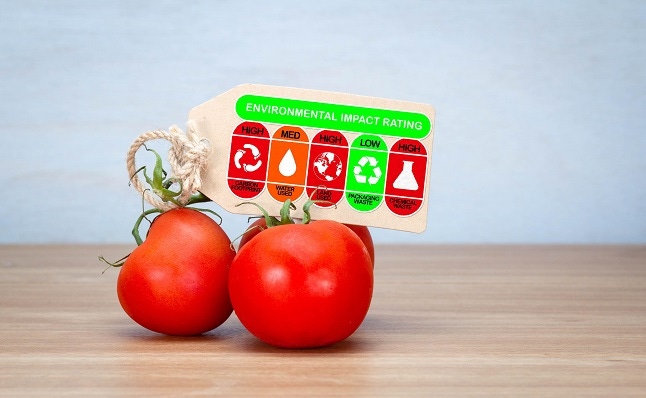Carbon Labeling and Emission Tracking Takes Hold with Consumers
As organizations look to advance sustainability and ESG initiatives, many CIOs and business leaders are recognizing the advantages of keeping consumers in the loop.

Businesses across a wide swath of industries have turned to carbon accounting tools to gain broader and deeper insights into sustainability initiatives. Yet, amid mounting discussions about how to improve sourcing, boost supply chain efficiency, and reduce energy consumption, there’s often a missing element: providing consumers with data about their habits, actions, and behaviors.
That’s beginning to change. Over the last few years, financial firms such as American Express and MasterCard have introduce emission trackers that allow customers to view their carbon footprint based on purchases. Meanwhile, consumer package goods producers have introduced carbon labels and travel providers such as Google Flights and Uber have rolled out tools that show emissions data.
“Enterprises have been calculating their carbon footprint for years,” says Janel Everly, a senior director and analyst for Gartner. Now they are adapting software to deliver data to consumers and other business customers. “These sustainability tools are modeled similarly to enterprise ESG software, but for the individual.”
To be sure, providing customers with data about their purchases and overall consumption patterns represents the next frontier in enterprise sustainability and ESG. Although any given tool won’t deliver a complete picture, they can deliver valuable insights to customers and reinforce a brand. As Everly puts it: “This information allows individuals to align their purchases and investments with their environmental focus.”
Banking on Progress
It’s hardly a news flash that consumer buying decisions increasingly hinge on factors such as a company’s carbon footprint, focus on biodiversity and environmental commitment. “Younger generations in particular are highly aligned with the idea of buying sustainable products,” observes Ron Kinghorn, US ESG and sustainability leader at consulting firm PwC.
Indeed, if climate change isn’t enough of a wake-up call, evolving consumer values should be convincing. McKinsey & Company found that 66% of all respondents and 75% of millennials consider sustainability issues when making a purchase. MasterCard reports that 85% of consumers are willing to take some type of personal action to combat environmental and sustainability issues.
As a result, new tools and techniques are popping up. MasterCard’s personalized carbon footprint tracker, developed in collaboration with Swedish fintech Doconomy, delivers a month-to-month view across spending categories. It also includes tips on how customers can reduce their carbon footprint and it provides donation options. The software is built on an API that allows banks to customize the tool and include it with their digital offerings.
The American Express web tool, introduced in 2023 to customers with a US consumer or small business primary card, displays estimated carbon emissions for the prior 30-day period, including the equivalent miles driven in a typical car (which makes the data more tangible). A more detailed screen shows an individual’s carbon footprint for up to 120 days across various categories. The site also includes tips and ways to contribute to carbon removal projects selected by Carbon Direct.
“We’re focused on advancing climate solutions by minimizing carbon emissions across our own operations and providing our customers and partners with low-carbon solutions,” states Lisa Yokoyama, senior vice president and head of products at Amex Digital Labs. The company worked with the CoolClimate Network at the University of California, Berkeley to develop the feature and the underlying methodology.
American Express also operates a Corporate Carbon Offset Referral Suite that allows companies to better manage their carbon footprint. It assists with carbon offsets, connects companies with providers, and offers tools to aid in carbon measurement. “These tools enable card members to better understand carbon emissions associated with their spending and provide insights and tips that help them make more conscious purchasing decisions, Yokoyama explains.
Breaking the Labels
While credit card companies can deliver a fairly broad view of each customer’s carbon footprint, other firms also see opportunity in providing sustainability data. For instance, Uber’s reporting tools allow businesses to analyze factors such as the number of trips taken, what percentage of the trips involved low emissions, average CO2 emissions per mile, and total emissions by average CO2 per mile.
Carbon labels are also taking hold, particularly in the consumer-packaged goods (CPG) industry. Independent companies, such as Cocokind and Oatly, now provide detailed carbon labels on their products, and CPG giant Unilever has announced that it plans to include carbon labels on its 70,000 products.
Numerous other opportunities exist, Kinghorn says. A clothing manufacturer might include the carbon footprint for shirts or shoes or allow customers to search for items based on criteria, such as “plant-based products.” A restaurant chain might display carbon data alongside menu items or at its website. Hotels and cruise lines might provide data or charts in their apps -- and even offer incentives for customers to reduce carbon emissions when they reuse bedding or adjust a thermostat.
It’s also possible to use QR codes to direct consumers to more detailed sustainability information and other resources, including tools that track and manage their carbon footprint, and options to make contributions to environmental causes or buy carbon offsets, Everly points out.
Yet, whatever direction a company takes, Kinghorn says that it’s vital to ensure that sustainability data -- and any claims -- are well vetted, accurate and fully explainable. “Consumers and activists are scrutinizing this information closely,” he cautions. “You don’t want to wind up facing accusations that you��’re greenwashing or become the target of a regulatory investigation.”
These challenges are compounded by the fact that constructing a data framework to support labeling and emissions calculators remains difficult, Kinghorn says. “There isn't a single system that can deliver this type of information. These tools require an ecosystem, and it is different for every industry and sometimes for every business.”
Beyond the Numbers
For now, most carbon tools pull commodity data from the Greenhouse Gas Protocol, though independent sites and private firms, such as Doconomy, have introduced indexes along with product impact calculators that cull data from publicly available ESG reports across tens of thousands of companies.
Ultimately, CIOs and IT teams must work with line-of-business leaders, business partners and others to build out more granular and precise data feeds. This might include the use of RFID, blockchain and ambient IoT in the supply chain -- and tapping the right set of APIs. It’s important to take Scope 2 and Scope 3 emissions into consideration, when possible, and deliver useful and actionable information to customers, Everly argues. “These tools should have the capability to baseline and benchmark year-over-year progress towards their goals.”
It’s also important to stay tuned to changes in regulations, Kinghorn says. “Regulators are increasingly examining claims companies make and holding them accountable.” This includes data that may touch customers only indirectly, he says. For companies with data that touches the European Union, he suggests keeping an eye on the EU’s Corporate Sustainability Responsibility Directive (CSRD), which requires a far more granular level of disclosure for companies operating in the EU. It will be phased in during 2024.
Providing customers with a clearer view of their carbon footprint will almost certainly move into the mainstream over the next several years, Kinghorn predicts. “Right now, we’re a bit early in the adoption curve but it’s clear that consumers seek this type of information, and they increasingly make buying decisions based on how they view companies.”
What to Read Next:
Special Report: What's the Environmental Impact of a Data-Driven Organization?
4 Green IT Businesses Working to Reduce Computing’s Impact on the Environment
About the Author(s)
You May Also Like
How to Amplify DevOps with DevSecOps
May 22, 2024Generative AI: Use Cases and Risks in 2024
May 29, 2024Smart Service Management
June 4, 2024







